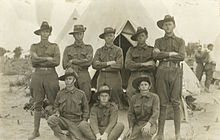World War I defences of Australia
In the years before World War I, the Australian Government began the process of raising a large civilian militia to defend the country against a feared attack by Japan.
[1] The Australian Government also expanded the pre-Federation network of coastal defences to provide protection against raids from Japanese or German warships prior to World War I.
[11] The gunners remained at their stations for the rest of the year, as it was feared that the German armoured cruisers Scharnhorst and Gneisenau could attack Australia.
However, on 1 January 1915 twenty members of the 82nd Infantry Battalion assisted the police to kill two men who fired on picnickers during the "Battle of Broken Hill".
[13] Members of the coastal artillery units were not initially permitted to volunteer for overseas service in the Australian Imperial Force (AIF).
As well as manning coastal defences, these soldiers patrolled the coastline near major cities and guarded vital infrastructure such as water reservoirs and undersea telegraph cable landing points.
[16] The restriction on militia gunners serving overseas was lifted in 1916, and those who volunteered for the AIF were often posted to the 36th (Australian) Heavy Artillery Group.
[19] In October 1916 the government called up 37,000 reservists for a short period of compulsory training ahead of a plebiscite on whether conscripts should be compelled to serve overseas.
This effort proved unsuccessful as both reservists and their employers considered the training camps to be pointless and disruptive to the economy, and only 500 men chose to volunteer for the Citizen Forces.
[22] While a scheme to set up a reserve force manned by AIF veterans who had returned to Australia attracted 17,000 volunteers, they received no training.
[24] On 20 November 1917, one of the coastal guns at Fremantle fired on the Japanese cruiser Yahagi when she gave an incorrect signal while entering the port.

